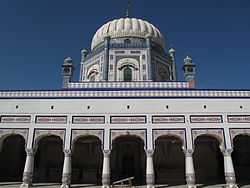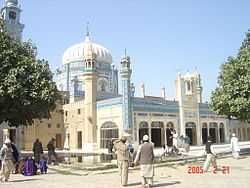Taunsa Sharif
| Taunsa تونٚسہ | |
|---|---|
| City | |
 Taunsa Location in Pakistan | |
| Coordinates: 30°42′20″N 70°39′28″E / 30.70556°N 70.65778°E | |
| Country | Pakistan |
| Region | Punjab |
| District | Dera Ghazi Khan District |
| Capital | Taunsa Sharif |
| Towns | 1 |
| Union councils | 13 |
| Area | |
| • City | 300 km2 (100 sq mi) |
| • Metro | 10 km2 (4 sq mi) |
| Elevation₳ | 157 m (000 ft) |
| Population (200000)₳ | |
| • City | 000 |
| • Density | 000/km2 (0/sq mi) |
| • Urban | 000 |
| • Urban density | 000/km2 (0/sq mi) |
| ₳ | |
| Time zone | PST (UTC+5) |
| • Summer (DST) | PDT (UTC+6) |
| 28700 | 28700 |
| Area code(s) | 0642 |
| ₳ | ₳ |
| ₳ | |
Taunsa (Punjabi,Urdu: تونٚسہ), also called (Taunsa Sharif تونسه شريف), is a city and capital of Taunsa Tehsil (subdivision) of Dera Ghazi Khan District in the Punjab province of Pakistan.[1] The town has important Sufi shrines, the most notable is that of Hazrat Muhammad Suleman Taunsvi.


Etymology
It is customary in Pakistan to use the postfix Sharif with the name of any place with a saint is buried, hence, the city is also called Taunsa Sharif.
Location
Taunsa Sharif is located on the Karachi-Peshawar Highway, which is also known as Indus Highway, it is approximately 975 kilometres (606 mi) from Karachi and 450 kilometres (280 mi) from Lahore. Taunsa is also the location of one of the headworks on the Indus River called Taunsa Barrage, located several kilometres south of Taunsa city.taunsa is linked by 4 provance
Tribal area
Tribal area taunsa sharif is 20 km away from taunsa city. Tribal area has two man union conceal as Barthi and Fazla. In Barthi the Heren Bore is very educated area in tribal area where Aztani Lives. Haji Ghulam Nabi Aztani was great Person of Buzdar Qabila. Now a day Haji Muhammad Qasim is the chief of Aztani Qabila. Master Manzoor Ahmed Aztani was a great and gentleman in Aztani May Allah give him place in Janat ul ferdos. ameen. qaisrani tribe is another larger tribe of the area. Qaisrani is a warrier tribe and has its long history of wars and bravery.
Demographics
Taunsa Sharif, a tehsil (subdivision) of D.G.KHAN district in Pakistan has an 80% literacy rate and place of loving people. Nowadays the local populace mainly speak the Balochi language and 10% part of the population also speaks Saraiki. The city itself contains a range of ethnic groups, including the Chhachi and Bhutta tribes. The old mohalla's are mohalah Shirani Wala, Chachan wala, Bhutan wala, sakhani, khwajgan, city is the adjacent towns and rural areas in the Tehsil are primarily occupied by Baloch , GAUDI and Lashkarani BALOUCH & , Buzdar, Lashkarani, Muchrani, Malkani, Qaisrani, Chandio, Lashari, khoja, khawjgan Nutkani, Lalwani, Khosa Baloch, Sakhani, Kalati, Nasuha, Malghani, Bughlani, Dasti Baloch, Khetran, Makhdoom and Kulachi. Most of the above mentioned tribes including Nasuha and Malghani are part of the Nutkani tribe. Qaisranis are the kings of TAUNSA The Buzdar,Muchrani, Nutkani (including all subtribes) and Shirani are the dominant tribes of Taunsa Sharif. The Shirani, a collection of Pashtun tribes, migrated from Barkhan Balochistan to Taunsa, Khawaja Shah Suleman came from Darug Balochistan and belong to Jaffar tribe. The Kulachi tribe came from Kulachi Tehsil (NWFP) in 1867.
Taunsa Barrage
Taunsa is also the location of one of the notable structures on the Indus River called Taunsa Barrage, located several kilometres south of Taunsa city. It was designated a Ramsar site on March 22, 1996. The Taunsa Barrage was completed in 1958, and it has been identified as the barrage with the highest priority for rehabilitation. It requires urgent measures to avoid severe economic and social impacts on the lives of millions of poor farmers through interruption of irrigation on two million acres (8,000 km²) and drinking water in the rural areas of southern Punjab, benefiting several million farmers. In 2003, the World Bank approved a $123 million loan to Pakistan to rehabilitate the Taunsa Barrage on the River Indus whose structure had been damaged owing to soil erosions and old-age. The project was designed to ensure irrigation of the cultivated lands in the area of the Muzaffargarh[2] and Dera Ghazi Khan Tehsil[3] canals, and through the Taunsa-Panjnad Link Canal that supplements the water supply to Panjnad headworks canals.
References
External links
| ||||||||||||||||||||||||||||||